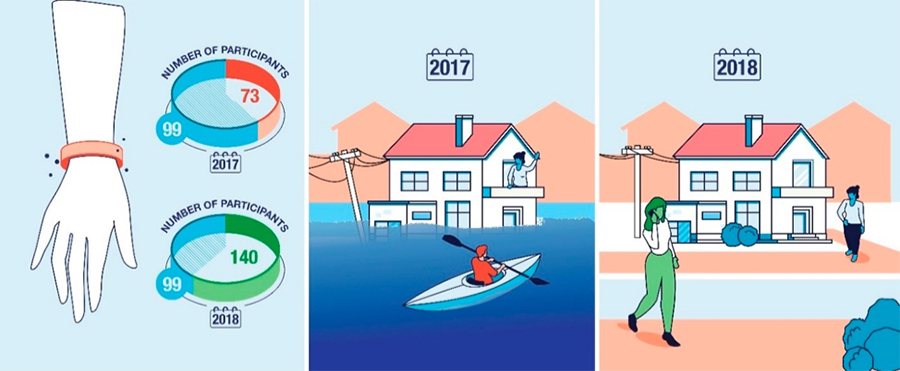Title: Study Shows Higher Chemical Exposures Following Hurricane Harvey
By Lee Cannon
The Impact of Natural Disasters on Chemical Exposures
A recent study led by Kim Anderson, Ph.D., from Oregon State University, funded by NIEHS, reveals that human exposure to harmful chemicals increases in the aftermath of natural disasters. The researchers used silicone wristbands to measure chemical exposures in Houston residents during and after Hurricane Harvey in August 2017.
Natural disasters like hurricanes are becoming more frequent and intense worldwide, posing risks not only in terms of physical injuries but also potential exposure to hazardous substances. Understanding how disasters can alter people’s exposure to harmful chemicals is crucial for protecting public health.
For instance, Hurricane Harvey caused damage to oil refineries and chemical plants, leading to the release of chemicals into the air and water. The flooding also impacted Superfund hazardous waste sites, potentially releasing toxic pollutants into the environment.
“Disasters in major industrial centers present unique risks for chemical exposures,” Anderson explained.
Using Silicone Wristbands to Measure Exposures
Anderson and her team developed a technique using silicone wristbands to track chemical exposures. These wristbands absorb chemicals similarly to how skin and lung tissues do, making them an effective tool for measuring exposure. The wristbands are less burdensome for individuals compared to other sampling methods, such as tissue sampling.
During the Hurricane Harvey study, participants wore wristbands immediately after the disaster and one year later. Analysis of the wristbands revealed higher levels of chemical exposures following the hurricane, with some chemicals linked to increased cancer risks.
The study detected various volatile organic chemicals (VOCs) and polycyclic aromatic hydrocarbons (PAHs), indicating significant changes in exposure levels post-disaster.
One challenge faced by the researchers was establishing baseline levels of chemicals in non-disaster scenarios. By repeating the sampling one year later, they were able to estimate pre-disaster conditions based on the data collected.
Key Findings and Recommendations
The study identified elevated levels of certain chemicals immediately after Hurricane Harvey, highlighting the importance of monitoring chemical exposures during and after disasters. The use of silicone wristbands proved to be an effective method for assessing personal exposure to harmful substances.
Anderson emphasizes the need for scientific infrastructure, networks, and partnerships for disaster response research before disasters occur. By establishing these resources in advance, researchers can better understand and mitigate the impact of chemical exposures during emergencies.

Participants wore and returned silicone wristbands during a post-hurricane timepoint in 2017 and again in 2018. (Image courtesy of Samon et al., Int J Environ Res Public Health, 2022)
The study underscores the importance of proactive measures in disaster research and response. By utilizing innovative tools like silicone wristbands, researchers can gain valuable insights into chemical exposures during emergencies, ultimately leading to better preparedness and mitigation strategies.
As Anderson aptly puts it, “You have to create the fire department before the fire.”
Citation:
Samon SM, Rohlman D, Tidwell LG, Hoffman PD, Oluyomi AO, Anderson KA. 2022. Associating increased chemical exposure to Hurricane Harvey in a longitudinal panel using silicone wristbands. Int J Environ Res Public Health 19(11):6670. doi:10.3390/ijerph19116670. [ Abstract ]
Please provide the content that you would like me to rewrite.









